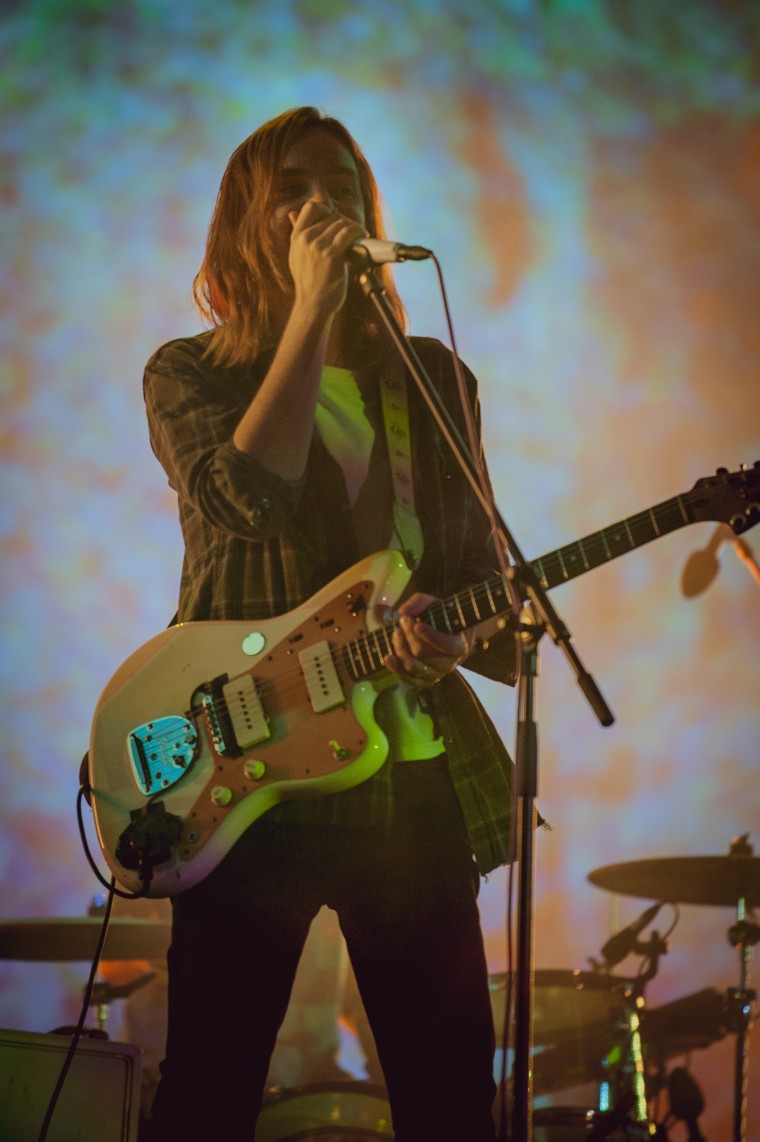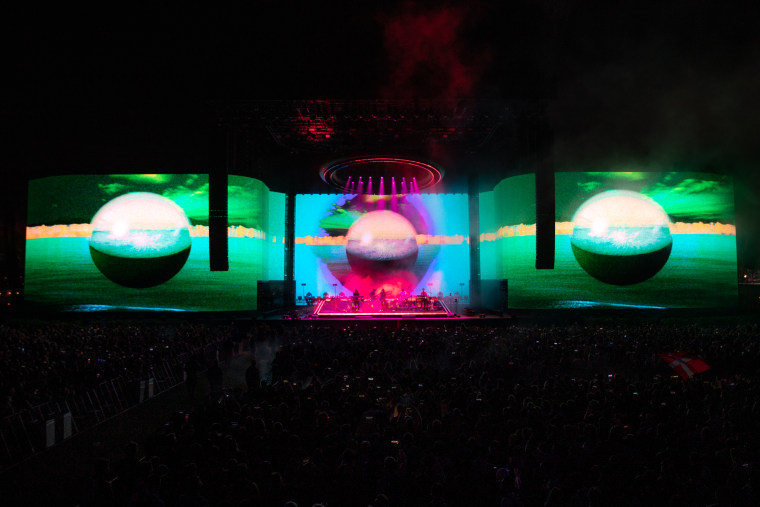 Tame Impala performs at Coachella in 2019.
Courtesy of Coachella
Tame Impala performs at Coachella in 2019.
Courtesy of Coachella
In the summer of 2003, a fiddle-loving preacher’s son fled Stockholm to seek refuge in the forest. Obsessed with Madlib and Jimi Hendrix, esoteric Scandinavian psychedelia and flute folk, the musician, who had figured that he’d wind up a truck driver, reinvented psychedelic music for the new millennium. Gustav Estjes called his band Dungen, but his bandmates were initially just auxiliary parts to help him flesh out his lysergic spirituals at shows.
The album that Estjes divined in those woods was called Ta DetLungt, which translates to “take it easy;” it sounded like a paradise of sunshine hallucinogens, celestial Viking jazz and universal health care — synthesizing acid-in-the-headband classic rock, Bitches Brew, bent brain boom-bap, and a benevolent government with lavish arts subsidies. You heard it once and suddenly wanted to quit your job, follow them around the country, and live off saucy meatballs and craft metallurgy bartered in freezing parked lots.
Tens of thousands of people agreed. There was a period in the middle of the last decade where it seemed like Dungen was set to take over the world. They were on the cover of this magazine (back to back with NORE no less). Pitchfork gave Ta Det Lungta 9.3. They were booked at VICE’s tenth anniversary party. Then they promptly disappeared from pop culture.
It wasn’t that Dungen stopped making music. Since 2005, they’ve released a half-dozen records, all of them very good to clock-melting brilliant, but each one received dwindling interest from critics and the American public. They still tour here every few years to small rooms full of a few hundred people, most of them cratediggers, psych-rock obsessives and musicians, who revere them as cult heroes and innovators who never received their proper due as one of the best bands of their generation. One of their card-carrying fan club members was a lank-haired loner from Australia’s remote provinces named Kevin Parker — who’s best known as the taciturn front-man of Tame Impala, the Windows Screensaver psych rock godheads who headlined Saturday night at Coachella.
 Courtest of Coachella.
Courtest of Coachella.
In the spot once filled by Prince, Guns N’ Roses, Radiohead, and Paul McCartney, there was Tame Impala, who fittingly played with the enthusiasm of a sedated woodlands creature. There’s nothing to dislike about Tame Impala, and that’s their greatest attribute. They’re as pleasant as a Target lava lamp, CBD oil in band form, Pink Floyd without the point. A friend of a friend murmured, “I feel like I’ve seen them a bunch of times at Coachella but I guess I’ve never seen them?” At three different points during their set, I forgot they were playing. It was like listening to a “Recommended if You Like Indica” playlist.
This is coming from someone who likes Tame Impala; I’m just baffled at how they’ve become the biggest rock band of the decade. Their first album Innerspeaker, is a modern psychedelic classic, even if Dungen gave them an entire style to run with. But whereas Estjes sang in Swedish, a decision that clearly halted his crossover success, Kevin Parker grafted John Lennon’s reedy whine to lyrics about modern ennui. The product was unimpeachable. You could take two hits of a roach, listen to“Why Won’t You Make Up Your Mind,” and debate where to get brunch for the next 25 minutes. They were the J.I.D. to Dungen’s Kendrick Lamar, an endearing apprenticeship talent who whittled the frenetic eccentricity from the original for something more readily digestible. Except there are as many people in the world who speak Swedish as there are living in L.A. County. By singing in their native language, Dungen was destined to become a roadside plaque commemorating their genius. And Tame Impala received a newly built and empty 5-lane freeway all to themselves.
Their sophomore album Lonerism found them hiring Flaming Lips producer Dave Fridmann, leaning more heavily on synthesizers and writing songs with titles like “Apocalypse Dreams,” which sounds like it was composed after eating a pair of Kush punch edibles and getting briefly lost on a hike at Joshua Tree. It’s a totally solid record from a totally solid band who are probably the only modern outfit that your dad would like. The riposte for another unreadable “Is Rock is Dead?” think-piece. A fat-free Cream.
From then on, things somehow managed to get totally bizarre and laserium boring. Tame Impala were the only new guitar rock band with a cool kid pedigree, that major label executives could also enjoy, understand and easily monetize. They signed to Interscope, refined their sound to arena rock mood music, and penned stuff like “Let It Happen,” “The Moment” and “The Less I Know The Better,” which had the faintest veneer of irony to let people know that yes, they had no clue how to navigate life, but the secret might be in chilling out. Which isn’t an incorrect point, but rather the most basic and rough. It’s music for day-trippers and Eat Pray Love seekers, who want to take ayahuasca for the rumored revelations but aren’t really down with that puking thing. So basically, A$AP Rocky, who conscripted them for a song called “Sundress,” which was co-produced by Danger Mouse because how could it not be.
Kevin Parker seems like an affable, thoughtful and kind person who is obviously musically gifted. But the machine that the band bought into has swept them into the largest stage in America at prime-time, where the implication is that you need a visionary statement, or at least a few new ideas, or barring that, a modicum of showmanship and imagination to mask the fact that they exhibit the charisma of the comatose.
 Tame Impala performs at Coachella in 2019.
Courtesy of Coachella.
Tame Impala performs at Coachella in 2019.
Courtesy of Coachella.
It’s fitting that their coronation occurred as streaming become the dominant music delivery system. They aren’t quite algorithmic rock like Greta Van Fleet, but they’re non-threatening, friction-less and the platonic ideal of a Woodstock reboot band (which they somehow got left off of). In the live setting, Tame Impala do everything to embody the psychedelic High Times cliché: a purple and dark blue tinted globe, floating clouds, smoke and strobelites, and distorted blurred imagery. A pre-rolled joint sold at Med Men. Tame Impala aren’t poseurs trying to exploit drug culture and cliché, they’re just content to ride it out. They aren’t even trying to break on through to the other side because they understand it probably sucks over there too.
Between songs, Kevin Parker banters with the audience, thanking them and telling them that they look so beautiful — then he pauses a beat and asks them to turn the lights up because he actually can’t see if this is true or not. The lights are turned up. Confirmed. He tells us that this is their fourth Coachella but he can’t remember what year they first played, which sounds about right. The set itself lasts a little over an hour and you eventually start to forget which sound is which, what album each comes from and eventually what decade we’re in. The new material sounds like gentle balearic disco to soundtrack “making love” to a palm tree. The stuff from the first two albums (“It Is Not Meant to Be,” “Elephant”) but the set is largely culled from their last, the major label debut, Currents — the one that made them and led to collaborations with SZA and Travis Scott and even inspired Rihanna to do a cover. And to be fair, they made it a hot line, she made it a hot song.
Tame Impala provided everything a psychedelic rock set should be, but not a second more. The guitars sounded crunchy and distorted, the vocals sounded bleary but clean, the drums boomed to echo the cavernous inner-peace you’d expect from people who collect crystals. But it was hard not to see them as seekers with nowhere to go, pleasant emissaries from a familiar place bearing old news, what happens when you get a little loose with Lo-Fi filter and the brightness slider. I mean it’s much better that it’s Tame Impala than whatever Imaginary Dragon alternative would replace them. Besides, it’s always 4/20 somewhere.


